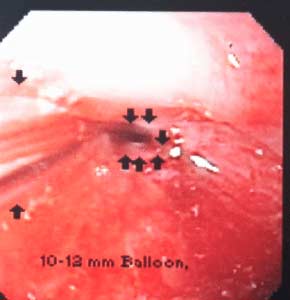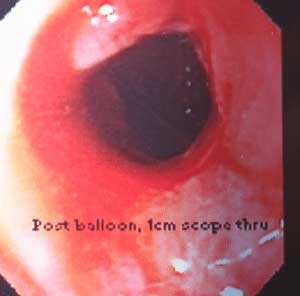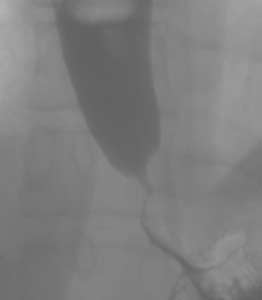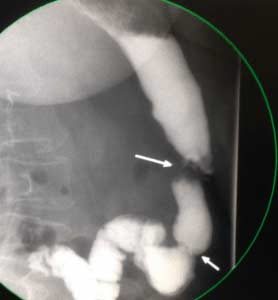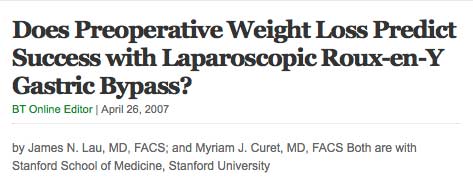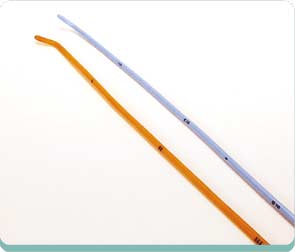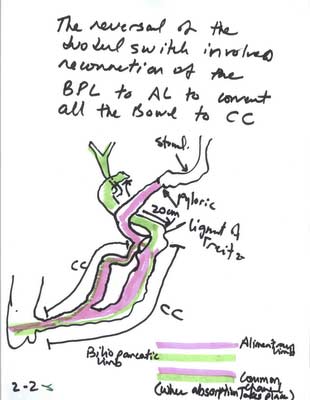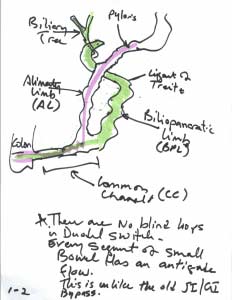Category: Sleeve Gastrectomy
GERD, Nausea and Vomiting- Don’t ignore it!
April 28, 2015 11:30 am
Gastroesophageal Reflux Disease is a serious matter and should not be left untreated. It is know as heartburn or reflux and if you are experiencing more than twice a week you should be evaluated by a physician to investigate the cause. Listed below are some of the causes and end results of not treating GERD.
Esophagitis – An irritant that can be acid, bile, food and digestive enzymes coming back up the esophagus can cause irritation and swelling in the esophagus. If left untreated, it can damage the lining of the esophagus to the point of erosion and scarring. Bile Reflux may also be a cause of esophagitis and Duodenogastroesphogeal reflux (DGER). Bile Reflux information here.
Esophageal Stricture – Scar tissue can cause the lumen of the esophagus to become smaller and narrow. This stricture makes it difficult or painful to swallow foods. If a stricture is narrow enough food may become stuck and require intervention for removal and treatment. This can also put a person at risk for choking. The treatment includes ballon dilation with an endoscope and in cases where it recurs surgery may be required.
Esophageal Ulceration– If GERD is left untreated it can progress to actual ulcerations in the esophagus. Patients may cough up or vomit blood or see it in their stool as dark tarry or coffee ground type stool.
Gastric Stricture– After weight loss surgery such as sleeve gastrectomy, RNY Gastric Bypass, Duodenal Switch, SADI/Loop, Adjustable Gastric Banding, or other gastric surgeries a narrowing of the inner opening of the stomach can result from scar tissue forming. This will require a surgical procedure to rectify. The symptoms can be food intolerance, full feeling, nausea and/or vomiting. (See pictures below)
Hiatal Hernia– An anatomical weakening or enlargement of the opening of the diaphragm muscle where the esophagus meets the stomach. This defect can allow a portion of the stomach to slide or roll into the chest cavity. This then causes reflux of gastric juice and content. Hiatal Hernia’s can also form on weight loss surgical patients. There are several examples within this blog here.
Breathing Difficulties– The acid aspiration while sleeping can make asthma and other breathing difficulties worst and can cause coughing and other issues.
Dental Issues – The acid, food, digestive enzymes backing up into the esophagus and mouth can cause dental issues such as erosion and tooth decay. In regards to dental issues after weight loss surgery there are also other vitamin and mineral deficiencies that can cause oral health issues. Dental Issues after WLS here.
Lower Quality of Life– GERD can affect a person’s quality of life. If you are in discomfort from acid reflux or having food intolerance it can make life difficult. It can also alter food choices and impact nutrition.
Barrets Esophagus– Pre-cancerous changes in the bottom portion of the esophagus due to long term acid exposure from gastric reflux. Diagnosis requires and endoscopic procedure (EGD) and biopsy.
Esophageal Cancer– There is a significant rise in the western world in esophageal adenocarcinoma. The main risk factors are alcohol use, smoking, untreated GERD, and poor diet.
Reflux and difficulty with swallowing caused by stricture is not normal. These problems are quite frequently encountered as complication of Adjustable gastric banding, with slipped band or a band that is too tight and scarred in placed resulting is belt effect. This results in the esophagus not being able to empty and propel the food down. The end result is significant reflux, with difficulty swallowing, nausea, vomiting etc. Similar problems are seen with Gastric bypass where the anastomosis between the stomach pouch and the small bowel RNY limb is too narrow. In Gastric Sleeve and Duodenal Switch operations, is the sleeve is made too narrow, or misshaped (hour glass, funnel, cork screw) it will result in the patient having reflux and symptoms of stricture. One specific problem with the new operation of SADI is the concern for risk of bile reflux, similar to the BillRoth I procedure.
Gastric bypass patient with stricture at the gastro-jejunostomy before and after balloon dilation. Fig A
After balloon dilation. Fig B
Fig. C : Lap band Patient with stricture where the band as removed at another facility and the scar tissue formed around the GE junction was not taken down. The patient had to be taken back to the operation room after his symptoms persisted even though the band had been removed 3 months prior.
A corkscrew stomach of a Duodenal Switch done at another facility, with the patient presented with persistent reflux, nausea and vomiting for years after surgery. Fig. D
This is not an inclusive discussion of GERD and the treatment. Please see your healthcare providers if you are experiencing any symptoms pertaining to GERD or any other health care issue.
Shared Success Story- Odessa D.
April 07, 2015 10:20 am
My name is Odessa D. I am going to talk about my weight loss journey with the lap band which started in 2006. At my heaviest I weighed 270 pounds and was a size 24 waist. I had high blood pressure, was a border line diabetic, had lower back pain, I had no energy, I was tired all the time, and I had sleep apnea.
My family doctor had suggested weight loss surgery but I was hesitant because I was afraid of surgery. Until one night my 8 year old daughter found me not breathing in my sleep. I made the decision to go through with the surgery.
Prior to surgery I did as much research as I could about the lap band. At the time I felt it was the right decision. On the day of the surgery everything went well. The first few months were great. I was losing weight, feeling good, feeling happy, and healthier then I have in years.
Then it began, all the symptoms of a slipped band. I started vomiting, nausea, acid reflux, and I was having trouble drinking and eating on a daily basis. My doctor confirmed it was a slipped band. We decided to replace the band because I was still overweight. On day of surgery I weighed 210 lbs.
After a month I started having symptoms of a slipped band. My doctor performed x-rays but everything looked fine. After 2 years with these symptoms and numerous doctor visits and x-rays I just gave up and learned to live with it. In 2 years I lost 4 lbs. My high blood pressure and sleep apnea came back. I finally decided to get the lap band removed. I wanted my life back and if that meant gaining the weight back that I lost then I was willing to make that sacrifice.
Dr. Keshishian was referred to me by 2 of his past patients. From the moment I walked into his office I was already at ease. When I first met Dr. Keshishian, I knew I was in good hands and I knew he could help me. He confirmed I had another slipped band and a detached port. At this point we discussed removing the lap band and switching to the Sleeve Gastrectomy. Finally everything was going to be fixed and everything was going to be right.
I can’t express how much my life has improved since removing the second band and switching to the sleeve. I have lost 46 pounds in 9 months. I now weigh 160 pounds and wear a size 8 waist. Now I look forward to each and every day with joy and pleasure knowing I don’t have to deal with a bad band and all the horrible symptoms that came with it.
Since the surgery and losing more weight I have been very active. I go hiking almost every weekend. I have literally climbed a mountain! I did my first 5k mud obstacle course in which my second 5k is in October. I even have a purple Mohawk! I have 100% confidence in myself and in everything that I do. My life has greatly improved since the sleeve. All thanks to Dr. Keshishian. It has been a very bumpy road with my weight loss journey but Dr. Keshishian has smoothed out the bumps and I plan on traveling the distance with many adventures along the way.
I would like to leave a huge “Thank You” to Dr. Keshishian and his staff. Thank you for making me feel welcomed, being friendly, making me feel comfortable, and especially for giving my life back to me. I can’t wait to see what the future holds for me and my family!
Thank you Dr. Keshishian and staff!
Odessa D.
Shared Success Story: Krystal U. Had a LapBand to Duodenal Switch Revsion
November 13, 2014 6:23 pm
Another amazing and emotional success story by Krystal Unruh. Krystal we celebrate you and your successful LapBand to Duodenal Switch revision. Thank you for sharing with us all.
Weight Loss before Weight Loss Surgery?
October 19, 2014 2:54 pm
I am frequently confronted by the question “Are you going to make me lose weight before I have weight loss surgery”? My answer is no, for several reasons, it makes little or no sense and there is scant scientific data to support it.
1-Anatomical and 2-psychological-behavior related variables have been suggested as the reasoning for the recommendations for diet before weight loss surgery.
Let’s see what the scientific evidence says about this.
1-Liver can be divided into two anatomical lobes. The tail end of the left lobe may extend all the way to the upper left side of the abdomen covering the upper 1/3 of the stomach, the gastro-esophageal junction (GEJ) and the esophageal hiatus. It was suggested that the access to the GEJ could be made easier, if the left lobe of the liver was smaller.
“A decrease in the size of the liver by 18% was shown in patients who were subjected to a very low-energy diet for 12- weeks.” This was published by Colles et.al in a small study of 39 subjects.
It is important to appreciate that this reduction in liver size meant that a patient would have to tolerate an ultra low caloric diet (less than 500/day) for 12 weeks. The interesting observation was that even with this reduction in the size of the liver there was “… no difference shown in morbidity, mortality, hospital stay, and decrease in morbidity- associated diseases whether there is preoperative weight loss or not.”
2-Behavior modifications have been entertained as a necessary element to the success of adjustable gastric banding. Numerous studies have shown that there is no predictive value of preoperative weight loss in relation to the weight loss after surgery.
The overwhelming scientific data suggest that there is no value to subjecting a weight loss surgical patient to a pre-surgical ultra low caloric diet.
“The California Department of Managed Health Care recently conducted a review of weight loss prior to bariatric surgery and concluded that “there is no literature presented by any authority that mandated weight loss, once a patient has been identified as a candidate for bariatric surgery, is indicated. This comprehensive review states that mandated weight loss prior to indicated bariatric surgery is without evidence-based support, is not medically necessary, and that the risks of delaying bariatric surgery are real and measurable.” Published by the American Society for Metabolic and Bariatric Surgery in March 2011.
Controversies of Duodenal Switch -Staged or Single Stage
September 27, 2014 5:29 pm
There is almost no science supporting the two staged duodenal switch. The “theory” advocated was that one can try a less invasive procedure and then if it does not work, proceed with the more complex operation. This was also advocated as a risk reduction tool for patient to have the sleeve component done as a planned first stage to reduce the operative and the anesthesia risk of the full duodenal switch operation. The “DS” surgeons soon recognized that the weight loss after sleeve is limited and not long lasting.
Laparoscopic Sleeve Gastrectomy has received a great deal of attention in the last few years. Most of this attention is contributed to the almost universal failure and high complication rate of the adjustable gastric banding (AGB) procedures. Since some practices and surgeons promised a low risk, minimally invasive procedure with the AGB procedures, they had to find an alternative as the complications and the failure of the AGB procedures mounted. This is when the Sleeve Gastrectomy started gaining more acceptance by surgeons who previously had performed AGB. Sleeve Gastrectomy is becoming one of the most commonly performed weight loss surgical procedure in several areas in the country and world.
It is worth mentioning, that Sleeve Gastrectomy is nothing new to the surgeons who perform Duodenal Switch procedures. Duodenal Switch has been performed as a single stage procedure since it’s inception.In fact every classical Duodenal Switch procedure is a Sleeve Gastrectomy with two small bowel anastomosis, first described by Dr. Hess in 1988. Duodenal Switch surgeons were also first to offer Sleeve Gastrectomy as the first stage of a two staged procedure.
BiliopancreaticDiversion-Duodenal Swtich: Independent Contributions of Sleeve Resection andDuodenal Exclusion, Marceu P, Biron S, Marceau S, et al. Conclusion: SG and DS independently contribute to beneficial metabolic outcomes after BPD-DS. Long-term weight loss and correction of metabolic abnormalities were better after DS favoring its use as first stage in BPD-DS; one-stage BPD-DS outcomes were superior to two-staged.
Other than some extreme cases, there is no indication to offer the sleeve as a staging operation since in vast majority of the cases the patient will require to have an alternative procedure done when the weight loss stops, and in some cases weight gain is experienced.
The reasons one should avoid a staged procedure is the evidence in the research data does not support that staging a procedure benefits the patient. There is also consideration for two general anesthesia exposures. Anesthesia time is based on surgical experience, technique and past patient surgical history. The argument that a patient should have the Sleeve Gastrectomy, to improve the risk for Duodenal Switch has almost no support in the peer-reviewed literature. One should also consider that a patient having had a Sleeve Gastrectomy may not qualify for the second stage Duodenal Switch procedure due to lower BMI or the insurance benefits mandating only one weight loss procedure in a lifetime.
There may be patients who may benefit from the Sleeve Gastrectomy long term, but in my opinion to offer Sleeve Gastrectomy as a planned first phase of the the duodenal switch is not indicated in majority of the cases.
What size is my Bougie?
July 10, 2014 6:57 pm
A Bougie is a flexible plastic tube that comes in different sizes. It can be used to calibrate the size of the stomach during the duodenal switch or Sleeve gastrectomy. It is also used to dilate strictures of the esophagus or the stomach.
I am commonly asked what size is the bougie that I use. My usual answer is that it is equivalent to a 38 or so, and that the size does not matter.
Many surgeons do not use these types dilators, but rather alternative tubes that function as a sizer and a suction tube to eliminates the need for multiple tube insertions and removals.
The July 2014 publication of Obesity Surgery had and article by Spivak et.al. titled “Laparsocopic Sleeve Gastrectomy Using 42-French Versus 32-French Bougie: The First-Year Outcome.” In conclusion they reported that using 42 vs 32 French Bougie does not influence the weight loss of resolution of the combed condition in the first year.
There also other studies that support the position of erring on the side a larger sizer, a 40-French, to decrease the leak rate without having an impact on the excess weight loss at 3 years time.
The take home massage is that the size of the stomach after the sleeve does not predict the outcome of the weight loss surgery independently. There are multiple factors in play such as age, amount of excess weight, diet adherence and exercise.
Revision or Reversal of the Duodenal Switch
September 08, 2012 7:00 pm
A significant portion of my practice involves the revision of the Gastric bypass and Adjustable Gastric Banding procedures to the Duodenal Switch operation. The re-operations are necessary to correct the complications that have been caused by these procedures. There are also instances of required revisions due to inadequate weight loss or weight regain. Our website contains detailed information regarding reasons for revision and the reversal of weight loss surgical procedures. I think it is important to mention that these complications are very common and almost never have anything to do with the patient’s behavior.
Duodenal switch operations may also require reversal or revision. The general reasons for a revision or reversal of the Duodenal Switch is the same as for all weight loss surgical procedures and include a variety of reasons. The reversal or revision of the Duodenal Switch operation is one of the simplest revision surgeries that I perform.
Let’s review a few facts about Duodenal switch.
The Duodenal Switch procedures has two components:
1.) The sleeve gastrectomy
2.) The separation of the biliopancreatic secretions from the food to limit its absorptions.
Clearly, the portion of the stomach that has been removed cannot be reintroduced to the abdominal cavity. The second part of the operation can, however, be easily “undone.
The assumption is that the bowel needs to be divided again and re-anastomosed to reconstitute its continuity. This revision or reversal of the Duodenal Switch operation is done by simply creating a new connection between a new anastomosis, located between the biliopancreatic limb, and the alimentary limb.
If a complete reversal is needed, then the connection is made just distal to the ligament of Treitz. Ligament of Treitz is the transition point between the duodenum and Jejunum. This single anastomosis is safe and simple to perform and does not involve removing the previous staple lines.
If a partial revision is needed, or the common channel needs to be lengthened, then the anastomosis is made further proximal to the junction of both the alimentary limb and the biliopancreatic limb, but distal to the ligament of Treitz to allow for increased absorption of the calories and nutrientsIn my opinion, the revision and reversal of the Duodenal Switch operation is, from a technical perspective, the simplest of all revisional weight loss surgical procedures.
In my opinion, the revision and reversal of the Duodenal Switch operation is, from a technical perspective, the simplest of all revisional weight loss surgical procedures.
Gastric Emptying after the Duodenal Switch and the Sleeve Gastrectomy
January 19, 2012 1:10 am
Sleeve Gastrectomy post operative diet
January 03, 2012 11:15 pm
A relatively common question asked post operatively regards the pace at which the post operative diet should be advanced. In our practice, patients are given a simple list describing 3 broad categories. They are outlined in the work book.
Each patient should advance his or her diet over a 1-4 weeks in the post operative timeframe. The most important point to remember is that each one of us responds differently to the food at a certain point following surgery. The safest method to advance the diet would be to pay attention to what your body is telling you. If a patient is tolerating Bariatric 1 and Bariatric 2 diet, then they should be able to advance to a soft diet in one or two weeks. Alternatively, if the patient is having difficulty getting their required water on a daily basis, then advancing to a soft diet may be an incorrect move at that point.The basic order of food is water, protein, and everything else.
Yearly lab and medication requests
October 17, 2011 5:28 pm
First, we now have preferred laboratories that have partnered with us. The laboratory results are expected to be sent to us electronically, which should cut down on the time between the blood draw and when the results are available to us. The information on the preferred labs is located at: https://www.dssurgery.com/lab. Needless to say, there are no financial incentives for us. You should also check with one of the labs, as well as with your insurance company, to make sure that they are a contracted facility and that the order is covered under your policy. It is your responsibility to make sure that your insurance company will pay for the labs ordered. We are in no way responsible for the verification of benefits for the laboratory services that we order.
Second, we have had to change the way we order our yearly lab work. As most of you are aware, it is critical that weight loss surgical patients have continuous yearly follow-up care and monitoring. It is critical that the patients continue to receive yearly follow-up care, not only by doing their scheduled laboratory studies, but also by a yearly follow up in office exam. We provide a comprehensive follow-up plan to the patients who have had the the Duodenal Switch or Revision from other failed weight loss surgical procedures. This includes ordering the laboratory studies, review and interpretation of the results, as well as office visits as frequently as required or deemed necessary.

